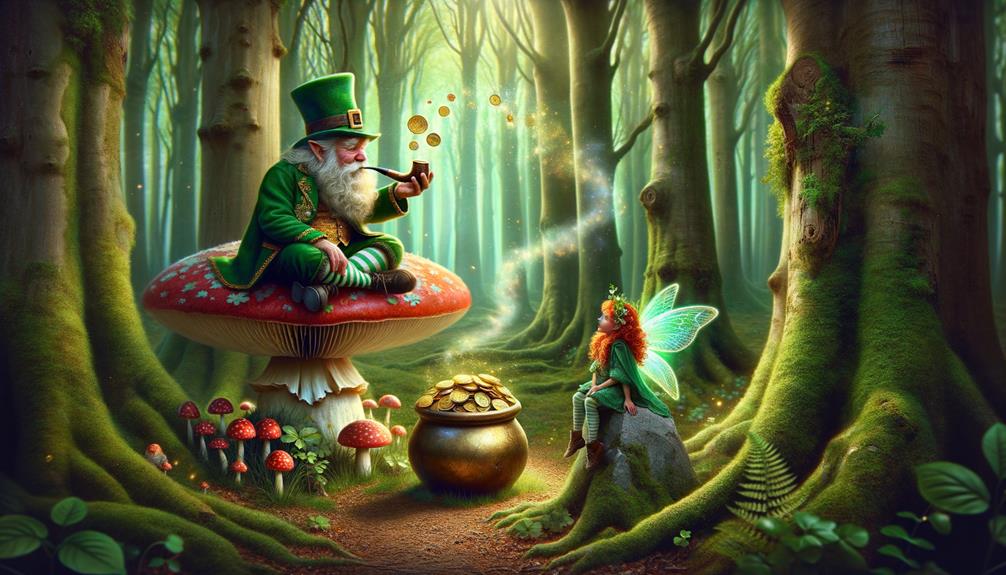As we journey through the lush landscape of Irish legends, one character always seems to steal the show – the leprechaun. These mysterious creatures, often dressed in shades of green, are much more than festive mascots of a lively St. Patrick's Day. They're a crucial piece of a rich tapestry of myth that's as layered as it is intriguing. From cobblers to collectors of gold, leprechauns have been attributed with a host of roles and traits, each one holding its own unique allure. But where did these mythical creatures come from? What's the real story behind their folklore? Aren't you excited to uncover the intricate tale spun around these playful beings?
Leprechaun Origins and History

Let's talk about the origins and history of leprechauns, shall we? These tiny beings, often depicted as solitary old men, stand out due to their distinctive clothing and preference for secluded places. They are an integral part of Irish folklore, falling under the broader category of beings referred to as the 'Little People.' Their heritage is linked to the Tuatha Dé Danann, a legendary Irish mythological race known for their magical abilities and wisdom.
The term 'leprechaun' comes from the Old Irish word 'luchorpan,' a nod to their petite size. It's quite interesting to see how this term from Ireland has become a significant emblem of their mythology, seeping deeper into the fabric of Irish history. These Irish fairies are recognized for their shoemaking skills and elusive behaviour, often linked to hidden riches and the granting of wishes. Their knack for cunning and trickery, paired with their connection to fortune and wealth, makes them a captivating topic for academic study.
Over time, leprechauns have surpassed the boundaries of folklore and found their way into various forms of art, literature, and promoting Irish goods. Their popularity in mainstream culture stands as proof of their lasting charm.
Appearance and Characteristics
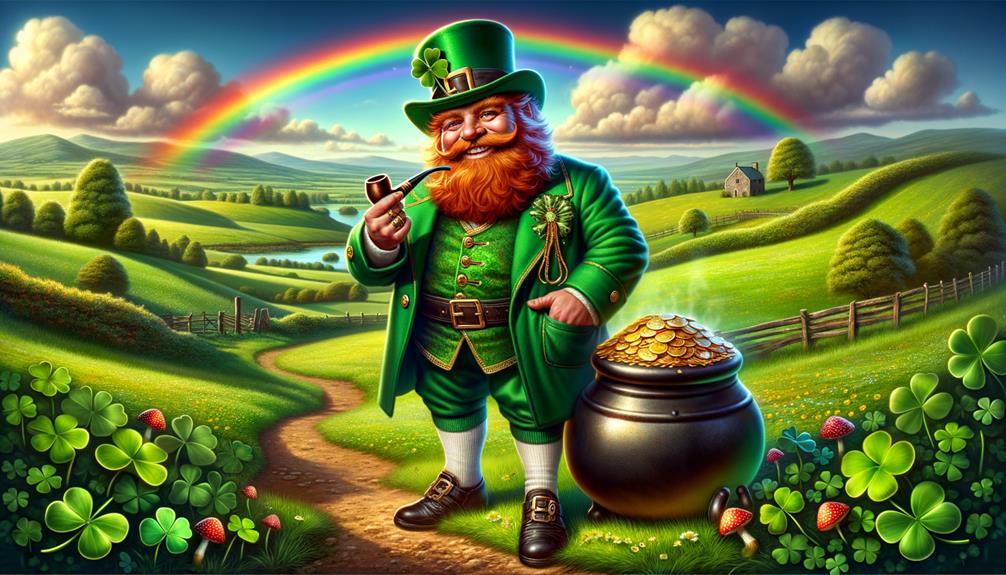
After digging into the roots and historical relevance of leprechauns, let's shift our focus onto their striking looks and unique traits. These aspects further shed light on their role in Irish tales and legends. In this realm, leprechauns occupy a distinct space as lone fairies. They are typically portrayed as small, bearded men dressed in green – a color that has come to symbolize the Irish nation.
Leprechauns are known to be skilled shoemakers. They make beautiful shoes, and the rhythmic tap-tap of their hammer often gives away their presence. Despite their petite size, leprechauns have a unique look and a set of traits that make them memorable:
- They're usually illustrated as small men with beards, often seen wearing a tilted hat and a leather apron.
- They're consistently shown in green attire, complete with a matching coat and hat.
- They're famous for their playful and tricky personalities.
- They're said to own a secret pot filled with gold.
Myths and Legends Surrounding Leprechauns
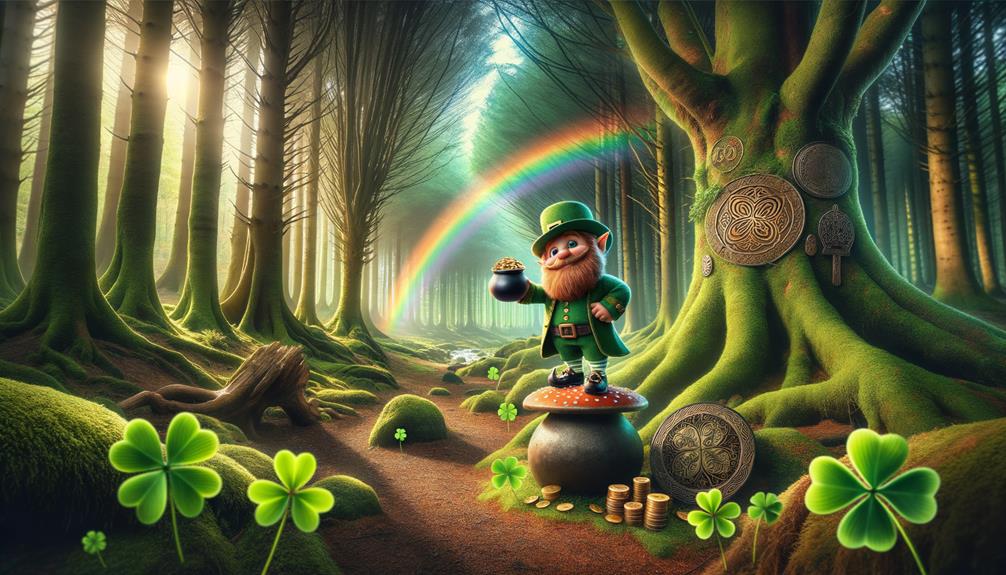
In the rich and vibrant world of Irish mythology, the tales spun around leprechauns present a captivating canvas of mischief intertwined with magic. These small, elderly men, embodying the image of the leprechaun, are legend for their sneaky antics and their mysterious connection with gold.
According to the famous Irish leprechaun lore, capturing a leprechaun means he is obligated to grant you three wishes, a price for his freedom. But beware, these creatures are crafty. They're notorious for using riddles and illusions to outsmart their captors, generally leaving the human empty-handed.
Let's summarize the most intriguing aspects of leprechaun folklore in the following table:
| Myth | Description |
|---|---|
| Gold Hoarding | Leprechauns are usually shown sitting beside a pot of gold at the end of a rainbow. |
| Three Wishes | If you manage to catch a leprechaun, he's bound to grant three wishes for his release. |
| Cobbler by Trade | Leprechauns are known to be shoemakers, often heard crafting a single shoe. |
| Solitary and Misanthropic | They value their solitude, avoiding interaction with humans and other supernatural beings. |
| Shape-shifters | They possess the ability to disappear in a blink or alter their shape, aiding in their getaway. |
Leprechauns in Contemporary Culture
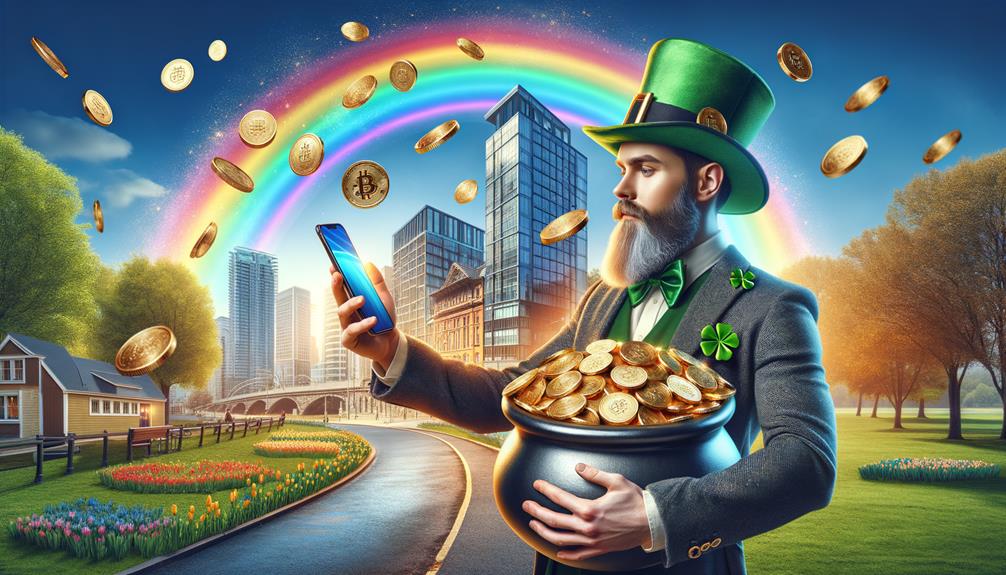
Leprechauns sure have a knack for popping up in today's media. Their transformation from Irish folklore's mischievous little creatures to symbols of fortune and prosperity is quite fascinating. They've become a common sight in promoting Irish goods and are often seen as lucky charms. Let's take a look at how these interpretations have taken shape in modern times.
Do you know about the Notre Dame Leprechaun? This spirited little fellow is the mascot for the University of Notre Dame's athletic teams, also known as the Fighting Irish. It's a nod to the deep roots shared between Irish and American cultures.
Next up, we have the Lucky Charms Cereal. This popular breakfast meal uses the leprechaun as its cheerful mascot. It's a fun way to start the day, don't you think? The leprechaun is seen as a symbol of good luck and prosperity, adding a little magic to your breakfast routine.
Another interesting concept is 'Leprechaun Economics.' This term was created to explain the skewed economic data caused by the influence of big multinational corporations in Ireland. It's quite an intriguing subject, isn't it?
Leprechauns also find their way into Celtic music and literature. Modern Irish authors and musicians frequently use leprechaun imagery, emphasizing its importance in Irish culture.
St. Patrick's Day celebrations have given the leprechaun a fresh coat of paint, bringing it out of the realm of traditional folklore and turning it into a lively, lucky figure. Despite this shift, leprechauns in today's culture still carry traces of their mythological beginnings, providing a vibrant reminder of Ireland's rich folklore.
Unusual Leprechaun Facts
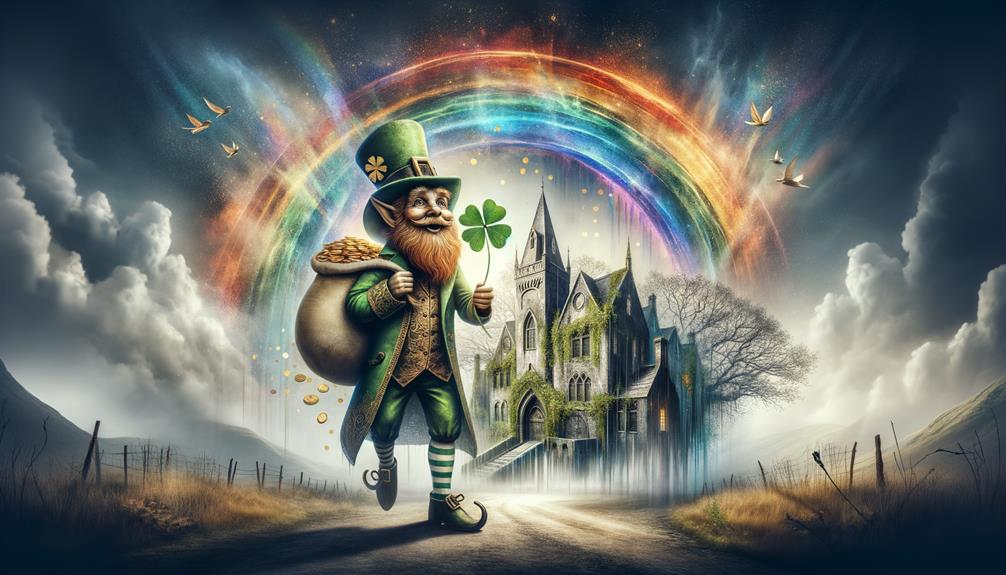
Leprechauns are more than just the familiar characters we see in popular culture. There's an array of intriguing and less well-known facts about these mythical creatures that add an extra touch of intrigue to their stories. Let's delve into the world of leprechaun folklore and uncover some fascinating tidbits about these little beings.
Despite what you may think, leprechauns haven't always been linked to the color green. Their original national costume was actually red, complete with a three-pointed hat. The green association came into play when Irish immigrants started incorporating it into leprechaun lore, tying it to the emerald hues of the Irish countryside.
The term 'leprechaun' comes from Irish language, which showcases their deep cultural origins. Interestingly, there are no known accounts of female leprechauns, which adds another touch of enigma to their narrative.
You've probably heard the story about gold at the end of a rainbow and that a leprechaun will grant you three wishes if you catch him. These tales contribute to their appeal. But there's a real-life twist to their tale too – in County Louth, Ireland, they have an annual leprechaun hunt, reinforcing their cultural importance and love among the Irish.
Frequently Asked Questions
What Is the Leprechaun Folklore Story?
You know, I've heard a fair bit about the story of the leprechaun. It's a classic tale from Ireland, telling us about these tiny, crafty creatures who spend their days making shoes and carefully hiding their gold. They're seen as symbols of good fortune and are a big part of Irish culture and traditions.
What Is the Main Idea of Leprechauns?
Got a minute? Let's chat about leprechauns, shall we? These little guys are a big part of Irish folklore, celebrated for their cheeky tricks, crafty nature, and knack for guarding hidden riches. Leprechauns typically keep to themselves, but they're more than just mythical hermits. You see, in the world of Irish myths and traditions, they're symbols of both luck and wealth. So, next time you spot a rainbow, keep an eye out for these playful guardians of the gold!
What Does the Leprechaun Symbolize?
From what I gather, the leprechaun is a symbol that is deeply rooted in Irish culture. It represents the tricky pursuit of wealth and luck, showing us the delicate balance between chasing riches and facing the consequences of uncontrolled greed. It's like a mirror reflecting some aspects of our human nature, and at the same time, it's a key element that shapes the identity of the Irish community.
What Is the Moral of the Story of the Leprechaun?
The leprechaun's story serves as an important lesson about the dangers of greed and dishonesty. It nudges us to realize that genuine success is the fruit of earnest work and honesty, rather than shortcuts or deceitful means.

